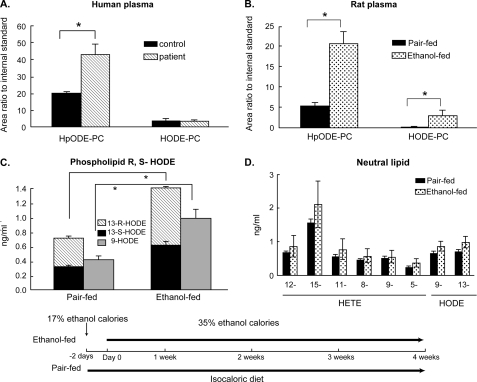FIGURE 1.
Hydroxy- and hydroperoxy-phospholipids increase in the circulation after chronic alcohol exposure. A, plasma phospholipid hydroperoxides from alcoholic patients. Human plasma was collected from patients with documented early stage alcoholic liver disease (n = 3) or healthy individuals (n = 5). Circulating levels of the oxidized phospholipids HpODE-PC and HODE-PC were measured as described under “Experimental Procedures.” B, plasma hydroperoxides in rats ingesting ethanol for 4 weeks. Plasma HpODE-PC and HODE-PC in rats (n = 5) chronically ingesting ethanol to provide 35% of their caloric intake or in paired control animals fed the same number of calories consumed by its paired ethanol-fed rat on the previous day (inset timeline). *, p < 0.05 comparing ethanol-fed to paired control. C, circulating oxidized phospholipids are a mixture of regio- and stereoisomers. Stereo- and regioisomers of H(p)ODE esterified in circulating phospholipids from rat plasma (n = 4) were determined by HPLC and mass spectrometry as described under “Experimental Procedures.” *, p < 0.05 comparing ethanol-fed to paired controls. D, oxidized fatty acyl residues in circulating neutral lipids. Regioisomers of arachidonoyl-derived HETEs and linoleoyl-derived HODEs in neutral lipids of rats maintained for 4 weeks on the Lieber-DeCarli ethanol diet or their isocaloric controls are shown. The inset depicts the experimental design where animals either ingest an ethanol supplemented liquid diet or are pair-fed an isocaloric diet for the stated times. Two days prior to the start of the experiment, animals in the ethanol-fed arm are habituated to the diet with lesser amounts of ethanol.

